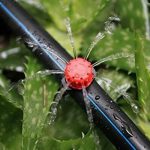Most areas in Kenya do not receive adequate rainfall for growing crops, hence farmers need to get creative. Water is a scarce resource that needs to be preserved. In the process of getting water to the crops, farmers are affected by winds and evapotranspiration. This results in wastage of water, especially in areas where farmers rely on man-made sources or seasonal rivers. Irrigation systems play a vital role in commercial farming, especially in areas where farmers rely on irrigation to grow their crops and plants. The agricultural sector keeps advancing, coming up with sophisticated irrigation technology that promote agriculture even in dry seasons. Drip irrigation systems have resulted to an increase in the production of fruits and vegetables as more farmers try to tap the high demand in the local and international markets. Apart from irrigation, drip irrigation systems can also be used for fertigation. However, one should be careful when designing an integrated irrigation and fertigation systems.
How to succeed in Drip Irrigation system
[caption id="attachment_4587" align="alignright" width="150"] Drip Emitters[/caption]
Drip Emitters[/caption]
The success of the system depends on the quality of the equipment. Irrigation systems should be installed in a professional way to minimize malfunctioning in certain parts. Drip irrigation systems help in delivering more water to the plants in a controlled manner, minimizing wastage and saving up to 60% of water consumption compared to sprinkler and flood irrigation systems. Some drip irrigation systems can be automated which can save you manual labor and time. When integrating drip irrigation and fertigation systems, one requires system pumps to control the flow of water and liquid fertilizers, drip tubing for pressurized distributing of water and fertilizers, emitters for distributing water to the farm, fittings, and emission devices. Emission devices are based on the crops grown and the type of soil on your farm. Filters are required to separate solid particles such as sand from the water before delivering it to the farm.
Fertilizers are added to the soil to supplement supply a certain number of nutrients to the crops. For instance, plants need nutrients such as potassium, nitrogen, calcium, phosphorus, sulfur, and magnesium. If these nutrients are not present in the soil, the plants would be forced to only survive on carbon dioxide in the air and hydrogen, oxygen and carbon from the water. Using fertilizers, farmers can boost the health of the plants and in the process increase the overall yield by 30-50%.
Fertigation
Fertigation is the application of irrigation water together with fertilizers. Once they are prepared in stock tanks, the concentrated fertilizer solutions are then injected into the irrigation systems using fertilizer injectors. In Kenya, this is done through drip irrigation systems. With fertilizer injectors, drip irrigation users have an advantage for they can easily apply to their crops. The irrigation system is composed of emitters and tubings which supply water to the plants. Using the same delivery system, fertilizers can be injected and applied to the plants' root zone where they are needed. When coming up with an integrated irrigation system, farmers should first know the size of the area to be irrigated, the quantity and quality of the available water, the crop water requirements, and the soil type. This will help the farmers to know how to disinfect, filtrate and oxidate the water, and what nutrients should be added for better crop growth. The efficiency of the fertigation program depends on the water management techniques implemented. The crop's water requirement is based on the type of crop, climatic conditions such as wind, humidity, and temperature, and stage of the crop. To maximize the crop's health, growth and yields, farmers should take close care to the concentration of liquid fertilizers and the timing of the system. In some units, especially the smaller ones, the injection rate of the fertilizer is proportional to the water discharge rate. Once the system has been run, it cannot be adjusted hence farmers should look keenly at the feed ratio.
To prevent the fertilizing agents from getting back to the water supply, the drip irrigation systems should be fitted with a backflow preventer. Filling a fertilizer injector is done by unscrewing a fill cap, emptying the water in the unit and filling it with the undiluted fertilizer before it is injected into the irrigation water. To prevent clogging in the drip emitters, only water-soluble fertilizers should be used.
Save Every Drop Through Drip Irrigation
Drip irrigation impacts the environment positively since it helps in improving crop production, water use efficiency and reduces CO2 emissions brought about by water pumps and reduces soil erosion, which is common in flood irrigation. Integrating irrigation and fertigation is an important advancement that can benefit both small scale and large scale farmers. Whether you are growing fruits, horticultural crops, you need a drip irrigation system integrated with a fertigation system to help you. There are many suppliers of these systems and it would be disappointing to buy something that doesn't work for you. For Irrigation kits and installation contact us.











